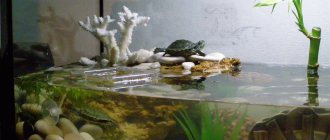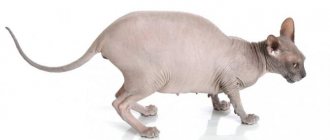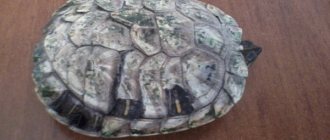Keeping red-eared turtles
Keeping red-eared turtles often turns out to be more difficult than expected at first glance.
Turtles spend most of their time in the water, although they definitely need land. An adult turtle needs an aquaterrarium with a volume of 100-150 liters, preferably that land occupies about 25% of its area. If possible, soil or crushed stone is poured on the shore. A gentle ascent with a rough but non-scratching surface is arranged to land. The water level must be greater than the width of the shell, so that if the turtle finds itself on its back, for any reason, it can turn over and not drown.
The water temperature in the aquarium should not be lowered below 20°C, the normal temperature is 24-30°C (it is advisable to install a heater to maintain the temperature). The water in the aquarium is replaced as needed, 1 - 2 times a week. A water filter allows you to do this much less often. However, a complete water change should be done at least once a month. It is advisable to install an incandescent lamp above the island in the aquarium. Turtles love to bask on dry land. Also, for the normal maintenance of a red-eared turtle, a source of dosed ultraviolet radiation is necessary.
In captivity, the diet of red-eared turtles includes small crustaceans such as gammarus or shrimp. Small aquarium or river snails, small or cut into pieces fish, meat cut into small strips, liver, small frogs, tadpoles, various insects and their larvae, earthworms, bloodworms, and tubifex are also suitable.
Do not forget that the diet of red-eared turtles should include foods rich in calcium: fish heads, bone meal, chalk, eggshells, etc. The diet of adult turtles also includes plant foods. Pets eat well dandelion leaves, cabbage, lettuce, spinach, and plantain. Among algae, duckweed, elodea, spirogyra, seaweed, anacharis, water beetle, edogonium, etc. are well eaten. Young red-eared turtles are fed 2 times a day. Later they are transferred to single meals. Turtles over 2 years old should be fed no more than 2-3 times a week.
You should not feed your turtle the same thing; the diet should be varied. The amount of food is selected so that the turtles eat everything without leaving anything in the water. Turtles should be fed at the same time every day. It’s good if the turtle has warmed up well before this. At a temperature of 28-30°, turtle digestion is much more intense. You can also feed turtles outside the aquarium, for example in a basin with water. This will help keep the aquarium clean. If the turtle's food is not particularly varied, it should be given vitamins or vitamin complexes. You can find them in pet stores, choose those marked “for reptiles.” Vitamins are fed to hungry turtles in their food. The dosage must be looked at in the instructions for the drug.
Conditions and care for red-eared turtles
It will take a lot of effort to create a comfortable habitat for a turtle. Due to the fact that the conditions of a hot tropical climate are natural for them, it is necessary to purchase a set of equipment to maintain optimal temperature conditions. In addition, you will need a large aquaterrarium, lighting fixtures and filtering devices.
It should be taken into account that only healthy young specimens should be purchased for a home aquaterrarium. You should not buy a turtle that has various external defects, such as:
- curvature of the shell;
- absence of claws or part of the tail;
- dents, growths or scratches on the shell;
- spots on the skin;
- inability to swim smoothly.
These signs may indicate developmental pathologies or the presence of a disease.
Aquarium and its equipment
When purchasing an aquarium, the most important question is how big does a turtle grow? The maximum length for this species is 25–30 cm (depending on gender).
Therefore, an aquarium should be purchased based on the future size of the pet. One adult requires a container with a volume of at least 150 liters. Keeping them in a smaller terrarium will not lead to slower growth and dwarfism, but to curvature of the shell and disruption of the internal organs.
In the first few years, 10–15 liters will be enough for a turtle to live a comfortable life. After all, a newborn slip-eared turtle is only 3 cm in size. However, it is worth considering that it grows quickly, increasing by 4 - 5 cm every year. And after a few years, keeping it in a small body of water will become dangerous.
In addition to purchasing an aquarium, you will need to purchase and install special equipment:
- Water heater with the function of automatically maintaining the set temperature.
- Water filter.
- Ultraviolet lamps. Without them, the production of vitamin D, which is involved in the absorption of calcium, is impossible. They are placed at a distance of no closer than 50 cm to the surface to prevent burns.
- Lighting and heating system. In nature, red-eared turtles live in a tropical climate, so they need a long sunny day (at least 12 hours), without which proper metabolism is impossible. The air temperature should be from +28 to + 32 degrees. For these purposes, incandescent lamps, mirror or gas-discharge mercury lamps are installed. At night, warmth is maintained using an infrared lamp. A drop in temperature can cause a slowdown in metabolism.
In addition, you need to equip the aquarium with a dry area with a small, gentle bridge for the turtle’s convenience. You can build it yourself using available materials (stones and tree branches) or buy it at a pet store. The turtle will rest, warm up and eat food on it.
If you decide to decorate an aquarium, then you need to consider the following points:
- Decorative elements should be made from natural or non-toxic artificial materials.
- All parts must be even and smooth without sharp edges that could injure the animal.
- Many living algae are poisonous to reptiles.
Aquarium for red-eared turtle
Water and soil
The red-eared turtle spends most of its life in water. Therefore, you need to monitor its quality especially carefully.
There are several rules regarding water in an aquarium:
- It must be free of chloride compounds and have a neutral PH level. This is achieved by long-term settling or simply using chemicals (dechlorinators).
- Its constant temperature should be from 21 to 27 degrees.
- Replacement should be done once a week. Without harm to the ecosystem, you can change no more than a third of the liquid at a time.
- Its quantity should be such that the turtle, standing on its hind legs, can stick its head out of the water. If the terrarium is too deep, then place a stand, stone or driftwood at the bottom.
Soil is not a necessary element of a turtle terrarium. If you still decide to use it for aesthetic purposes, then it is worth considering that the reptile is an omnivore and will definitely try to swallow everything that is inside the aquarium. Therefore, for backfilling you need to choose stones larger than a turtle’s head. The layer thickness should be from three to ten centimeters.
How to care at home?
Caring for a red-eared turtle consists of a number of simple manipulations:
- Cleaning the aquarium and equipment.
- Timely change of water.
- Cleaning the shell of small particles of algae and other dirt. To do this, wipe the animal with a clean cloth or clean it with a soft brush. No additional funds are used. The use of creams, oils and lotions is prohibited.
- Checking the correct operation of equipment and timely replacement of lighting fixtures.
- Organization of quarantine for new inhabitants of the terrarium.
- Control of animal movements outside the aquarium.
- Daily inspection.
- Proper nutrition.
Please keep in mind that it may take several days for your reptile to adapt to its new home. At this time, refusal of food and changes in behavior are often observed: hyperactivity or, conversely, inhibition of reactions. There is no need to try to contact the turtle at this time. Excessive attention will only increase your stress levels. The inadequate condition will go away on its own in five to seven days.
Nutrition
Like any living creature, a turtle needs a complete set of nutrients and minerals. In nature, it feeds on crustacean fry and fish, but does not refuse plant food.
Therefore, at home it is very important to ensure that the diet is as varied as possible and suitable for reptiles. It is best to use ready-made species that are available in pet stores.
Here the turtle also surprises its owners. She can live for two to three weeks without food. But a complete lack of appetite can be a sign of some kind of disease. Therefore, the fact that a reptile does not eat should not always be regarded as positive. But how many times a day to feed a red-eared turtle - this issue is decided individually, depending on the age and weight of the turtle.
What to feed a red-eared slider?
Due to the fact that these creatures are omnivores, their owners do not have to work hard. You just need to monitor the balance of the red-eared slider’s diet.
A healthy diet includes vegetables and fruits, aquarium plants, fish, insects, invertebrates, etc. You should not feed your pet exclusively with artificial (store-bought) food for red-eared turtles. Also make sure that the animal receives a sufficient amount of calcium and in no case overeats (this can lead to obesity).
Quadrupeds drink water in order to swallow food: after all, they do not produce their own saliva. You need to feed turtles every other day or two (adults over a year old) and every day (babies).
Turtles eat in the water. If you want to keep the liquid in the aquarium clean for a longer period, you can feed your pets in a separate container.
Got sick after a walk
During its long walk, the turtle could get sick from a draft, get dehydrated, get hurt when falling, and other pets could injure it. Observe the animal after it has been found. Let's look at the most common diseases and their symptoms.
- Pneumonia. Your pet was walking in a draft and got cold. Hoarse breathing, thick liquid appears in the mouth, runny nose, and later you can hear squelching breathing. Treatment and dosage are prescribed by the doctor, mainly intramuscular antibiotics.
- Runny nose. Possibly from dust or hypothermia. The treatment is simple, you need to rinse your nose, each nostril in turn. When rinsing properly, the liquid should come out through the mouth. When a turtle has a runny nose, it needs to be warmed up well.
- Fractures. When falling from an aquarium. If the fracture is closed, then in principle it will heal on its own; if the fracture is open, then surgical intervention is necessary. In any case, consultation with a doctor is necessary.
- Dehydration.
At the beginning of our conversation, we found out how long a red-eared turtle can go without water. But, if you find it more than 5 days later. By signs you can determine the condition of your pet
Sunken eyes, lethargy, in some cases muscle twitching, also pay attention to the skin. When squeezed with two fingers, the skin should straighten; if this does not happen, it means your pet is suffering from dehydration.
The doctor must prescribe treatment, but usually this is water and a special solution.
- Worms. If worms are detected, the help of a doctor is necessary, because you cannot get rid of some types on your own. Some experts advise feeding your turtle raw, grated carrots as a treatment for them.
- Lacerations. The wounds may come from other pets. A dog or cat may have injured the turtle. If such a situation arises, then it is necessary to remove the turtle from the water to avoid infection and to stop the bleeding. Treat wounds with an alcohol-free antiseptic. If the wounds are serious, then you need to see a doctor to get stitches. Do not put it in water for 2-3 days until the wounds begin to heal.
- Conjunctivitis. This is a highly contagious disease. If you have several turtles, then the sick one needs to be removed, and the common aquarium needs to be cleaned and the water changed. With this disease, the turtle's eyes become very swollen. It is necessary to wash the eyes with chamomile decoction and drip antibacterial drops 2 times a day. If the disease is severe, you can use tetracycline eye ointment. The illness should go away within a week.
- Stomatitis. Bad odor from the mouth, swelling of the mucous membrane and purulent formations in the mouth are the very first symptoms of stomatitis. With this disease, the turtle must be placed in a separate container to exclude the possibility of infection of other animals. This is a serious disease that we strongly do not recommend treating on your own.
- Dermatitis. The main symptoms: peeling of the skin, the appearance of acne, ulcers on the shell and paws. All this is caused by improper care of the turtle. Change the water more often, check the temperature of the water and on the island, balance the diet. Treatment is prescribed only by a doctor.
- .Constipation and diarrhea. The causes of these diseases always turn out to be poor nutrition. Review the feeding process itself. After feeding, turn off the light above the aquarium only after the turtle has gone to the toilet, otherwise constipation may occur. Also check that there are no small stones or sharp shells at the bottom that it can swallow. If she has diarrhea, it means you are overfeeding her or giving her fatty foods.
Watch your animals. Take time for this, because the better you know their habits, you will immediately understand if your pet is sick and will not waste precious time treating it. Do not self-medicate, but contact specialists. A competent diagnosis and timely treatment are the key to your pet’s longevity!
This is interesting! A special shelter for turtles has been opened in Switzerland. Adults who are no longer able to be kept at home end up there.
Should you pick up a turtle?
Let us remind you that red-eared turtles live at home in an aquarium . When removing an animal from the water, be prepared for it to be slippery. But this is not the main difficulty. The yellow-bellied creature is 100% likely to resist such contact. The turtle will begin to hiss, scratch you with powerful paws with sharp claws, bite, and it is possible that he will attempt to empty his bowels directly into your palm.
So in theory, you can pick up your pet, but is there a need for this tactile contact? If touching cannot be avoided, take the animal with both hands, fix it carefully but firmly, then the turtle will not slip out and you will not be bitten.
After contact, be sure to wash your hands with soap. Make sure that children do this especially. Explain to kids that affection with red-eared cats is unacceptable: these creatures, cute at first glance, can be dangerous, because carry salmonellosis. For this reason, animals should not wander around the kitchen and, especially, the dining table. You should also avoid washing your pet or its aquarium and accessories in the kitchen sink or bathtub.
Basic rules of care
Today, these reptiles have become very common pets. They are actively kept in medium-sized terrariums.
One cannot but agree with the statement that if any animal today can inspire admiration, it is the red-eared turtle. How long a given creature can be without water is a must-know for those who are used to walking a reptile at home. The reptile may well run away, crawl into the far corner of the room and hide. If it is not detected in time, it can easily die from lack of moisture.
This pet also prefers to eat outside of land. By the way, this is why the water in her “house” will have to be changed quite often.
History of the discovery of this species
It is believed that the first mention of these turtles dates back to approximately the 16th century. It was then that information about them was found in the records of Spanish colonialists who went to study the flora and fauna of Peru.
By the way, it is surprising that this reptile received such a name. Why is she red-eared? After all, neither she nor her relatives have what we humans could call ears. Like all reptiles, these sense organs are represented by the eardrum, located in the upper part of its tiny head. By the way, it should be noted that this reptile hears quite well. Sounds with a frequency of up to 300 Hertz are not a problem for him.
The very first description of a turtle was made more than 350 years ago. True, then it was mistakenly attributed to a completely different genus - Testudo. At that time, many animals were actively transported from continent to continent for study purposes. Red-eared turtles were no exception. How long these creatures can live without water was already tested in practice by many navigators. Unfortunately, many experiments then ended in the death of the animals themselves.
Some tips
- You should not place the aquarium in direct sunlight, because overheating is possible, and this will also negatively affect its health. The aquarium should be divided into zones: a heating and eating zone and a swimming zone, while the temperature is maintained at an optimal level in one or another zone.
- It is not advisable to install the aquarium in drafts.
- There should be 2 thermometers in the aquarium: one thermometer controls the water temperature, the other controls the air temperature on the island.
- The diet may include food of plant and animal origin, and such food is given alternately.
- Feed is provided only for feeding times. After eating, the dishes are removed with any remaining food so that it does not get into the water.
- It is advisable that a powerful filter be installed in the aquarium to purify the water. If there is no filter, then it is advisable to change the water every 2-3 days. The fact is that turtles recover in water, and if you consider that the water temperature is around +25ºС, then the rapid development of microorganisms is possible.
- Turtles need to take baths followed by cleaning their shells of dirt and algae.
- In summer, when the temperature rises above +20ºС, turtles can be taken out into the fresh air for sunbathing. For these purposes, you can use an inflatable pool, installing it with a slope so that there is some dry land.
- If it is not possible to expose them to the sun, then the turtles can be irradiated with an ultraviolet lamp, and this procedure must be done regularly, otherwise rickets may develop.
- For the sake of the interior of the aquarium, you should not place all kinds of driftwood and sticks in the water. Due to the fact that the water is warm, the wood begins to quickly decompose and spoil the water.
- You should not add neighbors to turtles in the form of aquarium fish. Turtles love fish very much and will not mind eating it, so they will soon catch them and eat them.
In conclusion, I would like to say that no matter who they have at home, they need care, constant attention and constant costs. As a rule, children insist on such a choice, and parents cannot refuse them, and they do the right thing, since such a living corner of the house not only introduces children to the animal world, but also contributes to the formation of a certain worldview, the basis of which can be love for our smaller brothers
But this does not mean that, having satisfied the wishes of your child, the worldview will develop by itself. Unfortunately, it is not.
CAUTION AND VIGILANCE
Charming red-eared turtles (Pseudemys scripta) are very funny creatures, cute, unpretentious, and require almost no care. They express their joy in a very interesting way when their owner approaches; they rejoice at the “sweets” by gurgling and whistling. You don’t need to play with them a lot or walk them for a long time; in the aquaterrarium they perfectly entertain themselves.
Having fallen in love with these creatures from friends, having played enough with them both in the house and in the sunny meadow, asking about the problems with maintenance and care, we decided to definitely set up a house for amphibians in our apartment.
What to do if the red-eared turtle does not open its eyes, what kind of disease is it and is it dangerous? Read here what to feed your ferret if it is your pet.
Adsense clicker for making money on Google AdSense from 500 to 1000 dollars per month
It describes how to care for hamsters and how to properly maintain them.
And now almost flat green patterned “pebbles” the size of a fingernail lie in warm water at the bottom of our aquarium. They lie there for half an hour, an hour...
There was no limit to delight when, after more than two hours, our “pebbles” came to life. We're holding our breath
The babies carefully poked their heads out from under the shell, showing those same bright red oblong spots near the eyes for which they are called red-eared
Then tiny paws with claws appeared. And then the kids swam, choosing a place to get to land. A barely noticeable movement - and there were two “pebbles” at the bottom again, although this time the kids sat motionless for only a short time.
Curious eyes sparkled with beads, heads were drawn to the treat: small earthworms and pieces of fish. And then the crumbs grabbed onto one of the worms. We were simply amazed by the appetite of the turtles.
They turned out to be real predators. But they stopped being scared only after a week, and for 7 days they hid at any movement, not wanting to get out onto land, run around the floor and play in front of witnesses.
We learned that the “babies” love to spend time under a lamp on a snag, warming themselves, stretching their paws and necks, drying every part of their tiny body. And we decided to get something more attractive and convenient.
Gradually, the aquaterrarium began to take on a lived-in appearance: islands for relaxation, ladders, platforms with sand, an ultraviolet lamp, driftwood. Our kids somehow climbed out along one of the ladders and platforms and plopped down on the table. They picked him up, examined him, saw that everything was fine and released him into the water. Since then, we have been carefully monitoring to ensure that there are no opportunities for pinnipeds to escape.
Video: proper care
How long will the “fugitives” live?
Didn’t our experience make you immediately carefully examine all the “toys” in the aquaterrarium? Using them, these tenacious and dexterous creatures, despite their apparent clumsiness, can climb to any height and fall to the floor, and then quickly hide in dark corners?
Then it is worth adding that it is dangerous for the health of red-eared turtles to stay in the air without the opportunity to plunge into water for more than 2 - 3 hours. Why?
Turtles of this species are amphibians; in nature they need fresh water, dense vegetation, a place to bask in the sun and to build nests.
Lakes and swamps with warm water, a small current, a sandy bottom - what else is needed for happiness? In nature everything is balanced. We basked in the sun, swam in the sand, and then in the water. Turtles never go far from moisture.
Interesting facts about the reptile
It would seem, what else might interest red-eared turtles? We have already found out how long these animals can go without water. But breeders claim that this is far from the most interesting fact from the life of this animal. What else?
For example, not everyone knows that, although such turtles are considered very unpretentious, their maintenance and breeding require a lot of time and effort. Of course, they spend most of their lives in a wet environment, but they also cannot do without dry land. Strange as it may sound, if they stay in water for a long time, they can even become weak and drown.
It is not for nothing that turtles of this species are considered long-lived animals. In captivity, they can please their owners for up to 30 years.
Scientists have proven that marine reptiles can swim underwater for a long time without emerging onto land. According to the observations of researchers, the record of stay of this type of reptile at the depths of the sea is 10 hours 14 minutes. Among all the vertebrates existing on Earth, no one else can withstand such a time in water without replenishing the supply of oxygen. It is the ability to accumulate oxygen in the lungs and hold their breath that helps amphibians make long journeys to the sea.
As for everyone's favorite domestic red-eared turtles, they cannot live longer than 3 days without immersion in water. That is why these animals, accidentally left on the floor or windowsill by children, painfully endure such treatment. They just might die.
In addition, these amphibians are sensitive to the purity of water and its temperature, which cannot be lower than 25 degrees. If this recommendation is not followed, the amphibian loses activity and appetite, and may catch a cold and get sick. She may perceive a decrease in temperature as a signal for hibernation and simply fall into suspended animation.
In the aquatic environment, the reptile swims, eats, defecates, and sleeps. Therefore, these amphibians are considered dirty. They need to regularly change up to 40% of the liquid in the aquaterrarium, otherwise they can catch infections, for example, eye inflammation, fungi.
Herpetologists explain that the younger the amphibian, the more time it spends in the water. With age, turtles more often swim to land and spend a significant part of the day there. Young individuals under the age of one year die without water. As for adults, they can live only on land for a day without significant damage to their health. On the second or third day their condition worsens and they may die.
A turtle house should have a lot of space for comfortable living. Therefore, for one individual you need an aquaterrarium of at least 100 liters, equipped with a ladder for moving from the water part to the land part, a filter, and a UV lamp.
General information about the representative of the world of modern fauna
From a scientific point of view, the red-eared turtle must be classified in the family of so-called freshwater Emydidae.
Experts believe that all representatives of this species can live in any, even the weakest, water bodies without problems. They tolerate even relatively low temperatures without problems, and are completely unpretentious in nutrition. It was all of the above features that allowed these animals to settle quite far from their natural habitat. Today they can be found in South and North America, Europe, Asia and even Africa.
The question of how long a red-eared turtle can live without water is, as a rule, of interest to both domestic breeders and those who observe its life in the wild. We answer: unfortunately, not for long. Scientists say that such a period should last no longer than 4-5 days, and even then in a relatively humid environment. Otherwise, the animal will die.
WHAT TO DO IF YOU MANAGE TO ESCAPE?
First, try placing a cup of water in a visible place and another cup with your favorite food. These creatures are very curious and have excellent eyesight, so a few minutes in silence and they should approach the treat.
If 2-3 hours have passed since the escape, and you still have not been able to find your pet, place saucers of water in all places accessible to it. In every dark corner, under the sofa, under the table. This is necessary so that the baby can find water and stay in it at least for a little while.
Several hours in the air can have a very bad effect on its skin and shell. Drying causes delamination of the shell, damage to the delicate skin, on which wounds and cracks subsequently appear that take a very long time to heal.
Don’t waste time, look at all the places where the turtle could have fallen, where it could have been trapped. Distance does not matter much for turtles: they are very nimble, able to move quickly, overcoming obstacles.
Remember that a turtle can hide in any dark corner for a long time
If you find contact with a pet, he will quickly make himself known; red-eared cats have good intelligence and can whistle, hiss, click, attracting your attention.
An adult red-eared cat has difficulty turning over from its back to its stomach, so if it falls badly, it may not be able to cope on its own.
Find out what to feed your hamster at home, what should be included in the diet, and what should be completely excluded. What do red-eared turtles suffer from and what effective treatment is recommended - https://tvoipitomec.com/cherepahi/bolezni-krasnouhih-cherepah-simptomyi-i- treatment.html
Video: what should not be allowed?
And a few more tips
- Do not place the aquarium in direct sunlight.
- Do not place where there are drafts.
- Maintain stable water and air temperatures.
- Feed plant and live food alternately.
- After feeding, remove any leftover food to prevent the water from spoiling.
- If there is no filter, change the water every 2 to 3 days.
- The turtles are washed in warm water, using a soft brush to remove dirt and algae from the shell.
- On sunny days, turtles can be taken out to bask in the sun in an inflatable pool, placing it on a slight slope and filling it with water so that part of the bottom remains dry. This is where the turtles will crawl out to dry. But if the temperature is below 20 degrees, bring them indoors.
We have never had to regret that we had these glorious creatures. But we made a lot of mistakes in the content.
Now our beauties have a shell with a diameter of 8 centimeters, they rejoice in the morning when people approach, willingly play with tennis balls, take food from our hands and even hear when we call them by name, rushing towards them slowly or very quickly.
What should you do if your red-eared turtle is hiding and needs to be placed in water?
This often happens if you let a turtle out for a walk around the premises and it hid in a secluded corner.
Since an animal may die without water, do the following. Place bowls of water in various nooks and crannies. The edges of the container should be low so that the reptile can climb into it. As soon as the animal senses water, it will go to it.
Let's draw conclusions. The red-eared turtle cannot live without water for long. Therefore, be attentive to your pets and treat them with care. This is the key to their health and longevity!
Content Features
It is possible to extend the life of a turtle with proper maintenance. The reptile needs both land and water. The pet must live in an aquaterrarium. It is strictly forbidden to keep turtles in:
- basins;
- buckets;
- boxes and other containers not intended for keeping animals.
The following recommendations should also be observed when maintaining:
It is extremely rare to pick up reptiles. This is allowed only when cleaning the place of residence; Turtles grow rapidly and need a lot of space. For small individuals, an aquarium with a volume of about 50 liters is enough. It is gradually increased to 150 liters; Do not place the container on the window. The turtle's place of residence should be in the back of the room; During the cold season, it is undesirable to open windows in the room in which the aquarium is located.
Otherwise, the risk of a particular disease in the turtle increases; It is important to monitor the temperature in the container in which the pet lives; Do not overuse the arrangement of various plants in the aquarium. Some species may be toxic to reptiles; The stones must be large so that the pet cannot swallow them; The aquarium must have a dry area
This is necessary so that the red-eared pet can warm up if necessary. The area should not occupy more than 25-30% of the total volume of the aquarium; The land should be dense and located at a slight angle; The aquarium should be well lit. There are two lamps. One of them is for heating, and the other is for lighting; The water in the container must be purified. We must not forget about replacing it. The temperature should range from 20 to 25 degrees Celsius.
By following all recommendations, the lifespan of a red-eared slider will increase to 30-40 years. The main thing is to provide your pets with all the necessary conditions and care, then they will feel completely safe. If everything is done correctly, the reptiles will grow quickly and will always be in a positive mood.
Content Features
To safely keep an animal, novice breeders will need to construct a so-called aquaterrarium, which will be divided into two zones: land and water.
By the way, it is highly not recommended to keep (or walk) a reptile on the floor. And there are several reasons. First of all, you can accidentally step on it and injure your pet. Secondly, the turtle may well swallow small debris. And finally, the floor is a place of drafts, and this type of reptile is very susceptible to colds.
For an adult turtle, a 100-160-liter aquarium will be enough, the land area of which should be no less than 25%. Like all reptiles, red-eared turtles also prefer to rest on the improvised shore. How long these animals can remain without water depends largely on their age and health. But on average, they rarely stay on a platform or mound of stones for more than twenty minutes. After this, they again happily immerse themselves in their familiar habitat.
Choosing an aquarium
Before you bring your pet home, you need to prepare a house for it. A red-eared turtle at home will be very happy to walk on land, but it also really needs water. Ideally, this should be a terrarium. That is, a large cell in the middle of which there is a depression filled with water. But most often, an ordinary aquarium is taken, in which islands are set up.
A red-eared turtle at home can live long enough only if there are good conditions. And one of the most important factors is a large aquarium. For one individual 13 cm long, you will need a 100-liter bath. As it grows, you need to change it to a two-hundred-liter one.
Can a red-eared turtle live without water for a long period?
By nature, red-eared turtles are freshwater animals that spend most of their lives in water. But at the same time, they need a piece of land, which they go out to periodically to warm up in the sun. In the aquatic environment, this animal swims, eats, fulfills all its natural needs, and even sleeps. But how long can a red-eared turtle live without water?
Note! Young individuals spend most of their time in water; without it, they can quickly die. But an adult red-eared turtle can live without water for about 48-72 hours
But this reptile should still spend most of its life in water, for this reason, if you decide to keep it at home, then be sure to take care of the proper preparation of the aquaterrarium:
- For amphibians to live in, it is recommended to use a large aquarium. Its volume should be at least 150-20 liters. This volume should be used even if you bought an individual with a small size;
- It is worth taking into account the water thickness indicator. Its level should be at least 45-55 cm;
- compliance with optimal temperature indicators. The temperature should be +23-28 degrees C. At a reduced temperature, the turtle’s behavior will be lethargic, inactive, passive, and its appetite will completely disappear. In addition, the reptile can quickly catch a cold;
- It is recommended to keep the red-eared turtle in clean water, so it needs to be replaced regularly - approximately 40% of the total volume. This is also required due to the fact that these freshwater species are terrible dirty creatures.
Particular attention should be paid to the land area; its presence in the aquarium is a prerequisite. This area can be made independently or already prepared in a pet store, especially since these places sell a variety of figurines, houses, artificial stones of two or even three levels
When arranging sushi in a terrarium, it is worth considering several important conditions:
- The area of land should be non-slip, it should be slightly sloping. The animal should easily climb and descend on it;
- The size of the land island should be 30% of the total volume of the aquarium, and it should slope down into the water column;
- If desired, for maximum convenience, you can arrange an island with two levels. One part may be under water, and the other protrudes above its thickness.
Do not place the ultraviolet lamp too low over the land area, otherwise this can lead to burns and overheating of the freshwater animal. It is advisable to protect the lamp from various harmful fumes.
You should not cover the land area with gravel, earth, or soil. The fact is that the turtle will begin to eat the mound and this will lead to disruption of the digestive system.
It is recommended to place an electric pump with a filter in the aquarium. This device will be able to purify water from various pollutants and particles, and will also maintain the normal state of the aquatic environment. But even with this device, regular water changes will still be required.
How to treat an animal?
If this is your first time getting such a pet, don’t get lost. There is nothing difficult about caring for red-eared turtles at home. You just need to know what they are capable of and how they perceive our world. These four-legged animals have well-developed vision and sense of smell (turtles distinguish colors, detect other people's motor activity at a distance of up to 40 meters, and look for food by smell). But they hear poorly: after all, their ears are covered with skin. Only vibration and dull sounds are available to them. The shell is not just armor and protection, it is a part of the body that is very sensitive to touch because many nerves pass through it. Taste buds are also well developed: pets can refuse tasteless food in favor of some favorite treat.
The animals themselves make a variety of sounds: squeaks, snorts and hisses. Do not forget that turtles cannot breathe underwater; to breathe, they must rise to the surface. In general, these are very sensitive creatures that require special care. Organizing it is not at all difficult, the main thing is to follow the recommendations correctly.
As soon as you have a pet, get ready for a pleasant acquaintance, try to get to know your red-eared friend (or friend) better. Read the article: How to determine the sex of a turtle! Show it to the veterinarian: you won’t be able to make sure on your own that the new family member hasn’t brought a bunch of turtle diseases. If you already have turtles living in your house, don’t rush to add a new one to them. Arrange a kind of quarantine for her for 2-3 months (during this period you can make sure that the red-eared one is healthy).
Never place young turtles with old ones: “hazing” is rampant among these creatures, and often the “seasoned” inhabitants of the terrarium cripple the young ones.
Your pet needs time to adapt to an unfamiliar environment. During this difficult period, try not to bother him with your attention, do not pick him up.
Main characteristics of the species
These are medium sized turtles. In the shell, their length varies from 18 to 30 cm. Sexual dimorphism is manifested mainly in size - males are much smaller than females.
Juveniles are bright green, allowing them to hide among plants. As turtles mature, they acquire olive or yellow-brown hues with characteristic patterns of yellow stripes. These stripes give the reptile an elegant look, which attracts many who like to fill their home with unusual animals.
On the head, neck and limbs the patterns are especially pronounced. In an adult turtle, they are a combination of white and green wavy stripes and spots.
Turtles do not have ears.
Why then did this turtle get the name red-eared? Those who name species have their own logic and flight of fancy
Apparently, the zoologist who named this species noticed the elongated bright red spots on both sides of the head
They extend along the head from the outer edge of each eye. These red (or maybe orange or even yellow) spots are located where ears would be if they had ears. So we got a bright name for an unusual turtle.
This species has a wide range. Initially, its representatives lived only in Central America and northwestern South America.
However, humans contributed to its spread to other regions. Now these turtles live in southern Florida, Arizona, Guadeloupe, Israel, South Africa, Spain, Great Britain and even Australia.
This turtle is considered aquatic, but it is able to go onto land, bask in the sun and move from body of water to body of water. She prefers to live in small fresh lakes, ponds and other bodies of water with low, swampy shores. It feeds equally on animal and plant foods. However, she has not been shown to have a predilection for carrion. She needs fresh game (crustaceans, fry, tadpoles, etc.) or fresh grass, including coastal grass.
Under favorable conditions, these turtles lead an active lifestyle.
They swim well and are quite capable of catching up with a small fish at a short distance.
How long do red-eared turtles live at home?
When planning to have a reptile at home, you should take into account how many years red-eared turtles live; you may have to care for it for decades. But this is more of a plus than a minus. With good care, a turtle lives about 30-40 or even more years. But with an inexperienced or irresponsible owner, the turtle may die without even living for a year.
The main factors on which the lifespan of a turtle depends:
1. Balanced diet, optimal balance of plant and animal foods. 2. Living conditions as close as possible to natural ones: a large aquarium, proper heating, UV lamp, etc. 3. Maintaining hygiene, regular cleaning and maintenance of the terrarium. Caring for a turtle does not involve complex manipulations: regularity is important here. 4. Timely treatment of diseases. If the turtle’s behavior or appearance has changed, or it is lethargic and inactive, you should contact a specialist. 5. Communication with brothers. This recommendation applies more to small turtles, since adults prefer the company of their relatives to splendid loneliness.
What the future owner should know
This is a species of freshwater turtle that requires an aquarium with islands to roam around. Many people are interested in how long red-eared turtles can live without water. Long enough. Therefore, if a pet gets out of its aquarium and goes for a walk, the owner will have time to catch it and send it back to its place. So, what does a turtle’s life depend on:
- balance of plant and animal foods;
- conditions of detention, which we will discuss in detail below;
- hygiene;
- regular treatment.
Features of appearance and life
The red-eared slider is easily recognized by its appearance. It differs significantly from other representatives.
So what features does it have:
- There is a stripe of red or orange color on the head;
- The surface of the armor covering is smooth and rounded;
- The color is olive green with characteristic black or yellow stripes;
- The species of red-eared turtles differ insignificantly. Young individuals have a richly colored shell. The coating darkens with age.
The size of an individual is determined by the length of the shell. Coverage is measured from edge to edge
In this case, you should not pay attention to the bending of the surface. Measurements are taken using a ruler
By about a year, the size of the reptile is 6-8 centimeters.
The size of the turtle is directly related to the conditions of detention and the subspecies of the pet. The aquatic reptile usually reaches a length of 20 to 30 cm. Males are smaller in size than females.
The age of a turtle is not precisely determined by its size. When well maintained, individuals are large. Only a specialist can tell the exact age of the turtle. Approximate data can be obtained based on the size of the shell. Approximate data is given in the table.
| Approximate age | Shell size |
| 11-12 months | 5-7 cm |
| 2 years | 7-9 cm |
| 3-4 years | 10-16 cm |
| 5-6 years | 14-20 cm |
The world's largest red-eared turtle has a shell length of 40 cm. Males are usually 5-6 cm smaller than females.
How to extend the life of a turtle?
- When purchasing an ornamental reptile, learn about the natural environment in which its relatives live and its preferences.
- Make a varied diet, taking into account all the necessary minerals and vitamins.
- Make sure that the turtle does not live too crowded in the tank. For a medium-sized adult, select a vessel with a volume of 100 liters or more.
- The reptile should live only in a fully equipped aquarium. Pets live shorter lives in containers and boxes.
- Equip the aquarium with the necessary equipment: a water filter, an ultraviolet lamp and a heater.
- Bathe your pet at least once a week. The duration of water procedures is no more than half an hour. Aquatic species live in aquariums with a small pond and an island.
- Maintain the air temperature at 31–33 degrees, water temperature at 20–24 degrees.
- Be careful when handling the reptile, do not drop the animal or frighten it with sharp sounds. If children play with the pet, adults should supervise the process.
- If you notice anything strange in your reptile's behavior or appearance, do not delay checking with a veterinarian. Refusal to eat, changes in the shape of the shell, lethargy, the appearance of tumors and ulcers are signals of illness.
- When purchasing new armored reptiles, quarantine them for a month. At this time, the future neighbor must live separately.











